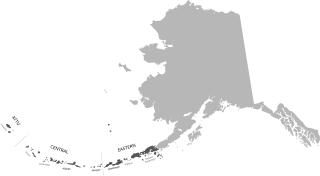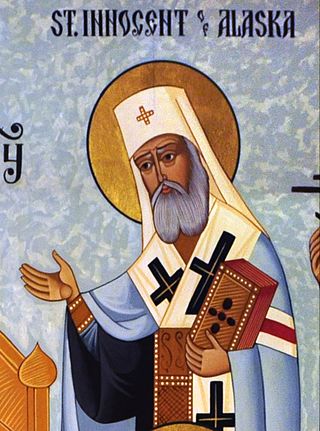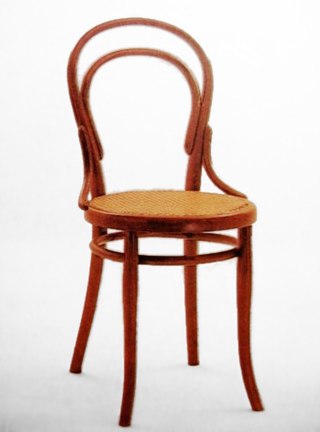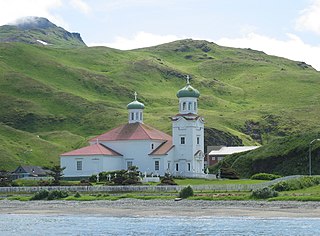
The Aleuts are the indigenous people of the Aleutian Islands, which are located between the North Pacific Ocean and the Bering Sea. Both the Aleut people and the islands are politically divided between the US state of Alaska and the Russian administrative division of Kamchatka Krai.

Sand Point, also known as Popof Island, is a city in Aleutians East Borough, Alaska, United States. At the 2010 census the population was 976, up from 952 in 2000, but by the 2020 Census this had reduced to 578. It is on northwestern Popof Island, one of the Shumagin Islands, off the Alaska Peninsula. It is the borough seat of Aleutians East Borough, and is near the entrance to the Bering Sea.

The City of Unalaska is the main population center in the Aleutian Islands. The city is in the Aleutians West Census Area, a regional component of the Unorganized Borough in the U.S. state of Alaska. Unalaska is located on Unalaska Island and neighboring Amaknak Island in the Aleutian Islands off mainland Alaska. The population was 4,254 at the 2020 census, which is 81% of the entire Aleutians West Census Area. Unalaska is the second largest city in the Unorganized Borough, behind Bethel.

The Eskaleut, Eskimo–Aleut or Inuit–Yupik–Unangan languages are a language family native to the northern portions of the North American continent and a small part of northeastern Asia. Languages in the family are indigenous to parts of what are now the United States (Alaska); Canada including Nunavut, Northwest Territories, northern Quebec (Nunavik), and northern Labrador (Nunatsiavut); Greenland; and the Russian Far East. The language family is also known as Eskaleutian, Eskaleutic or Inuit–Yupik–Unangan.

Aleut or Unangam Tunuu is the language spoken by the Aleut living in the Aleutian Islands, Pribilof Islands, Commander Islands, and the Alaska Peninsula. Aleut is the sole language in the Aleut branch of the Eskimo–Aleut language family. The Aleut language consists of three dialects, including Unalaska, Atka/Atkan, and Attu/Attuan.
Aleksey Mironovich Yachmenev was an Aleut chief who lived in Unalaska. Along with Leontiy Sivtsov, Yachmenev accompanied Waldemar Jochelson on his 1909-1910 ethnological studies on the Aleut.
Leontiy Ivanovich Sivtsov was a church reader who lived in Unalaska. Along with Aleksey Yachmenev, who like Sivtsov was Aleut himself, Sivtsov accompanied Waldemar Jochelson on his 1909–1910 ethnological studies on the Aleut.

Saint Innocent of Alaska, also known as Saint Innocent Metropolitan of Moscow was a Russian Orthodox missionary priest, then the first Orthodox bishop and archbishop in the Americas, and finally the Metropolitan of Moscow and all Russia. Remembered for his missionary work, scholarship, and leadership in Alaska and the Russian Far East during the 19th century, he is known for his abilities as a scholar, linguist, and administrator, as well as his great zeal for his work.

Bentwood objects are those made by wetting wood, then bending it and letting it harden into curved shapes and patterns.

Popof Island is an island in the Shumagin Islands south of mainland Alaska. The largest community in the area, Sand Point, is located on the northwest coast. Popof Island is 10 miles (16 km) long, 5 miles (8.0 km) wide and the peak elevation is 1,550 feet. It is located at 55°18′49″N160°22′29″W. It has a land area of 93.651 km2 and a total population of 578 persons at the 2020 census.
The Aleut Corporation, or TAC, is one of thirteen Alaska Native Regional Corporations created under the Alaska Native Claims Settlement Act of 1971 (ANCSA) in settlement of aboriginal land claims. The Aleut Corporation was incorporated in Alaska on June 21, 1972. Headquartered in Anchorage, Alaska, The Aleut Corporation is a for-profit corporation with approximately 3,410 Alaska Native shareholders, primarily of Aleut descent originating in the Alaska Peninsula, Aleutian Islands, Pribilof Islands, and Shumagin Islands of Alaska.

The Church of the Holy Ascension, also known as the Holy Ascension Orthodox Church, is a prominent landmark in Unalaska, the major community of the western Aleutian Islands in southwestern Alaska. The current church was built in 1894, probably on the site of an 1826 church, and likely using timbers and other elements from the older church. It is one of the oldest churches in Alaska, and is significant as the site from which missionaries brought their religion to the local Aleut people. This evangelization effort was so successful that today's Aleut population is still strongly Orthodox. The church was declared a National Historic Landmark for its architecture, and for its role in the history and culture of Alaska. It is the second cathedral church of the Orthodox Church in America Diocese of Alaska, after St. Michael's Cathedral in Sitka.

Unalaska is a volcanic island in the Fox Islands group of the Aleutian Islands in the US state of Alaska located at 53°38′N167°00′W. The island has a land area of 1,051 square miles (2,720 km2). It measures 79.4 mi (127.8 km) long and 34.7 mi (55.8 km) wide. The city of Unalaska, Alaska, covers part of the island and all of neighboring Amaknak Island where the Port of Dutch Harbor is located. The population of the island excluding Amaknak as of the 2000 census was 1,759 residents.

Steam bending is a woodworking technique where wood is exposed to steam to make it pliable. Heat and moisture from steam can soften wood fibres enough so they can be bent and stretched, and when cooled down they will hold their new shape.

Sergie Sovoroff was an Aleut educational leader. He was born on Umnak Island in the Aleut village of Nikolski in 1902. Sovoroff was born only nine years before the United States government outlawed sea otter hunting. After 1911, the need and use of iqya-x, Aleut sea kayaks, declined abruptly. But Sovoroff continued to see a need for creating model sea kayaks, known in his days by the Russian name "baidarka". Sovoroff "...kept up the tradition of making kayak models". Model sea kayaks built by Sovoroff, quite often with three hatches with a Russian Orthodox priest seated in the middle hatch, can be seen in many museums around the world. These model sea kayaks, finely crafted by Sovoroff, often equipped with a rudder on the stern of the kayak, all too frequently bear the name of the person who purchased them or donated them to the museum, and not Sovoroff's.

The Aleutian Islands, also called the Aleut Islands or Aleutic Islands and known before 1867 as the Catherine Archipelago, are a chain of 14 large volcanic islands and 55 smaller islands. Most of the Aleutian Islands belong to the U.S. state of Alaska, but some belong to the Russian federal subject of Kamchatka Krai. They form part of the Aleutian Arc in the Northern Pacific Ocean, occupying a land area of 6,821 sq mi (17,666 km2) and extending about 1,200 mi (1,900 km) westward from the Alaska Peninsula toward the Kamchatka Peninsula in Russia, and act as a border between the Bering Sea to the north and the Pacific Ocean to the south. Crossing longitude 180°, at which point east and west longitude end, the archipelago contains both the westernmost part of the United States by longitude and the easternmost by longitude. The westernmost U.S. island in real terms, however, is Attu Island, west of which runs the International Date Line. While nearly all the archipelago is part of Alaska and is usually considered as being in the "Alaskan Bush", at the extreme western end, the small, geologically related Commander Islands belong to Russia.

Unangan hunting headgear are wooden hats associated with the Unangan or Unangas, the Indigenous peoples of what are currently known as the Aleutian Islands.

Stephan Gavrilovich Glotov was a Russian navigator, explorer, and fur trader. He was the first Russian captain to enter the waters of the eastern Aleutian Islands, and was the European discoverer of Kodiak Island and several other Alaskan islands.
Jerah Chadwick was the Alaska Poet Laureate from 2004 to 2006. Most of his writing centers around the time he spent in Alaska in an abandoned World War II facility with his partner, Mike Rasmussen.
Agdaagux Tribe of Kind CoveAlaska is a federally recognized tribe based in Belkofski, Alaska. Population is found to be 845 people, 170 households, and 116 families in King Cove as of 2022. The tribe is made up of a mix between Unangax and non-native people.















